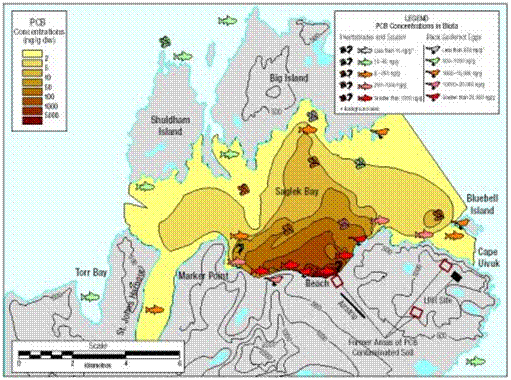




|
John Bubb |
|
|

|
PCB Contamination & Cleanup at Saglek |
|
PCB Contamination at Saglek (Updated December 2009)
Note: I try to keep these pages current but the web is a dynamic environment and sometimes links will disappear without warning. If you find a link that no longer works, please send me an email.
One unfortunate side effect of our work at Saglek was that the immediate area around the site became heavily contaminated by Polychlorinated Biphenols (PCB’s).
Polychlorinated Biphenyl (PCB)
(Source: http://www.epa.gov/epawaste/hazard/tsd/pcbs/pubs/about.htm)
PCBs belong to a broad family of man-made organic chemicals known as chlorinated hydrocarbons. PCBs were domestically manufactured from 1929 until their manufacture was banned in 1979. They have a range of toxicity and vary in consistency from thin, light-colored liquids to yellow or black waxy solids. Due to their non-flammability, chemical stability, high boiling point, and electrical insulating properties, PCBs were used in hundreds of industrial and commercial applications including electrical, heat transfer, and hydraulic equipment; as plasticizers in paints, plastics, and rubber products; in pigments, dyes, and carbonless copy paper; and many other industrial applications.
Remediation Efforts
This map obtained from a source that is no longer on the web and which I cannot attribute shows the extent of the contamination in the 1990’s as cleanup was in progress. This contamination affected local wildlife. Environmental reports of the time note the Sculpin and the Black Guillemot as being particularly affected. |

|
Those who worked at Saglek will note that the highest concentration of contamination was around lower camp. The source of the contamination was the soil in the lower camp area and, to a lesser extent at the BMEWS communication site and Upper camp. Cleanup of the contaminated soil occurred between 1998 and 2004 by the Canadian Department of National Defence. This cleanup was successful in ensuring that no further contaminants reached the ocean. The most recent testing reports that I can find present quite a positive outcome. Contamination in the waters are lower than expected and now below the level that might cause damage to wildlife. The remaining portion of this page is from one of the most recent reports:
Brown, TM, TA Sheldon, NM Burgess and KJ Reimer. 2009. Reduction of PCB contamination in an Arctic coastal environment: A first step in assessing ecosystem recovery after the removal of a point source. Environmental Science and Technology doi:10.1021/es900941w
Synopsis by Karen Kidd and Wendy Hessler
PCBs at a contaminated military site in northern Canada were once high enough to affect the reproduction of nearby fish and fish-eating birds. Now, only eight years after the area was cleaned up, the levels in wildlife have dropped remarkably, researchers now report. The findings are the first to show that Arctic wildlife can recover from intense pollution if the contaminated sites in these very cold-weather regions are remediated. |